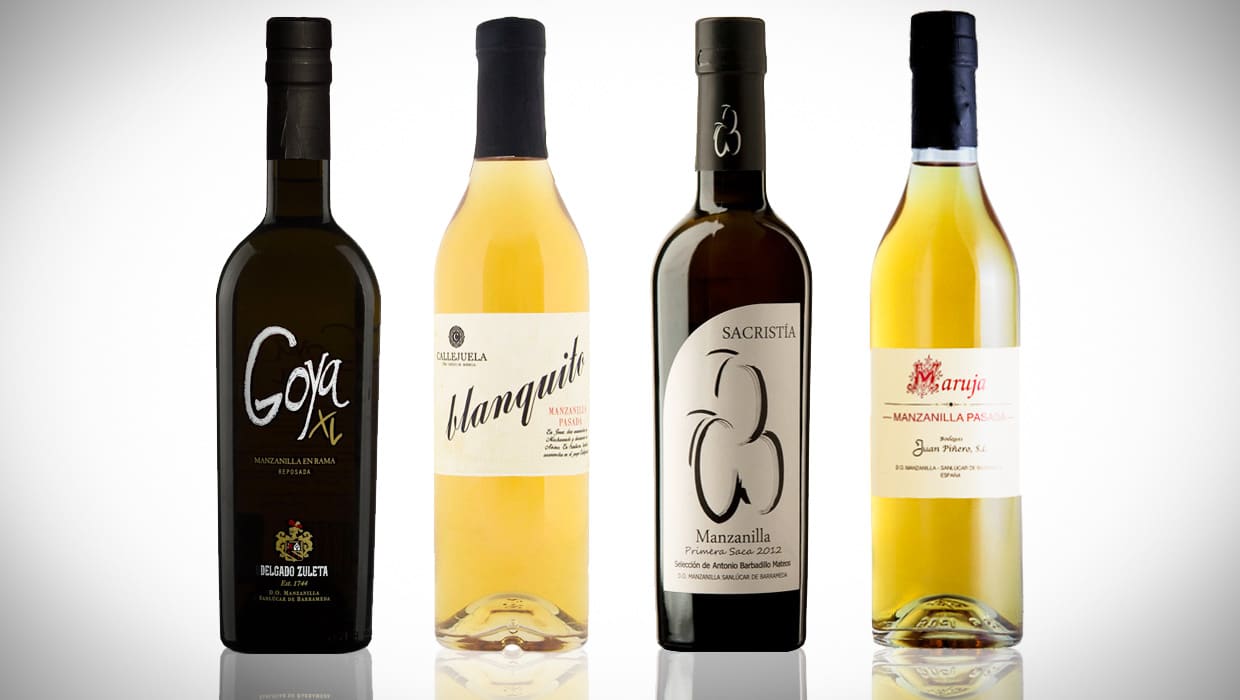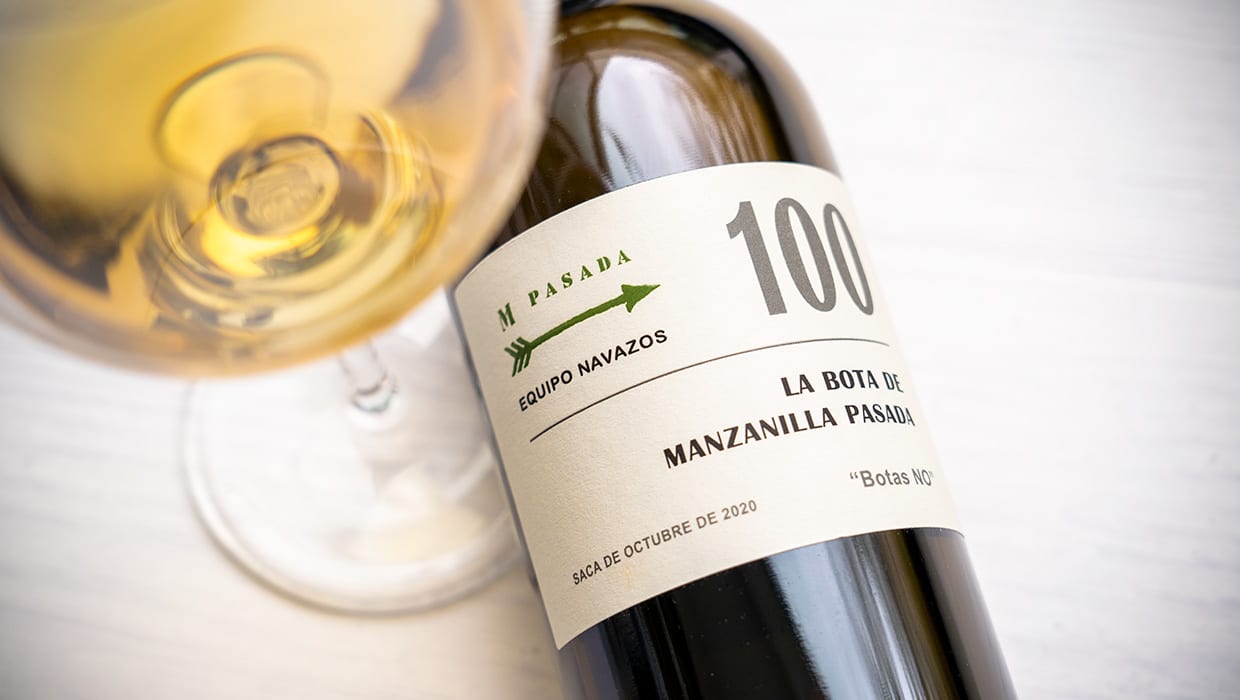
Manzanilla
Manzanilla is a dry white wine, aged for at least two years under a layer of flor yeast. Technically it is identical to Fino sherry, with one main difference: the location. Manzanilla can only be produced and matured around Sanlúcar de Barrameda, a town closer to the sea than Jerez. The climatic differences make it lighter than Fino wines. The wine is controlled by its own D.O. Manzanilla de Sanlúcar.
Some of the most renowned Manzanillas include La Gitana (Hidalgo), La Guita (Hijos de Rainera Perez Marin) and Solear (Barbadillo)
Manzanilla is made from the Palomino grape and biologically aged, entirely under a layer of flor yeast. The specific climatic conditions of Sanlúcar are responsible for a higher humidity and cooler, more constant temperatures than those found in inland bodegas, which contribute to a higher yield of flor all year round.
Like Fino, Manzanilla is produced in a Solera system, but it typically has more scales than their Fino counterparts. Barbadillo’s Solear has ten criaderas for example, and the Solera that produces La Gitana has fourteen. It is typically released at a younger age than Fino, but the best Manzanilla examples are still between three to seven years of age.
Manzanilla wine character
The thicker layer of flor protects the wine even more from air contact, resulting in a slightly lighter variety of Fino, containing virtually no glycerol and combining dry, saline notes with a fresh, zesty liveliness. Manzanilla typically displays more coastal aromas than a Fino, like seaspray, salty touches or even a hint of iodine.
In Spanish, manzanilla means chamomile, which is an aroma typically found in this type of sherry. Nonetheless the name of the wine supposedly comes from the eponymous village in the D.O. Huelva, a neighbouring winemaking area, on the other side of the Parque Nacional Doñana.

Manzanilla Pasada bottled by Equipo Navazos
Manzanilla Fina / Manzanilla Pasada
The flor in Manzanilla barrels will usually live for about 6 to 8 years. At that point there is not enough material left in the wine to survive (the sugar content of the wine will be below 5 grams per litre), and the flor gradually fades, slowly exposing the wine to oxygen. Depending on the stage of the flor, there are different classifications of Manzanilla:
- Manzanilla (sometimes Manzanilla Fina to differentiate from the Manzanilla Pasada) is the traditional Manzanilla sherry, typically bottled around 3 to 5 years. Maturation of at least 2 years is prescribed by law.
- Manzanilla Pasada is a richer, older Manzanilla in which the flor starts to fade. Until recently, some of the popular Manzanillas like La Gitana or La Guita were released as a Manzanilla Pasada, but due to their popularity and the consumer’s preference for a lighter style, nowadays they are bottled as younger wines. Since 2021 the minimum age for a Manzanilla Pasada is defined at 7 years of age.
Appreciation
Manzanilla is a perfect aperitif or accompaniment to a wide variety of foods. It is best served chilled – depending on the producer, a temperature of between 4°C and 9°C will be suggested. It goes particuluarly well with olives, (fried) fish, seafood and Jamón Serrano. Manzanilla is also an excellent combo with sushi and it makes a great, refreshing spritz / cocktail called Rebujito.
Manzanilla sherry reviews
- 3 En Rama – Spring 2020 (Lustau)4
- 3 En Rama Manzanilla 2015 – Sanlúcar de Barrameda (Lustau)3.5
- 4x Manzanilla Pasada4.5
- Almacenista Manzanilla Pasada (Lustau)4
- Aurora Manzanilla (Yuste)4
- Barbiana Manzanilla (Rodriguez La-Cave)3
- Domecq Manzanilla3.5
- Goya XL (Delgado Zuleta)4
- La Bota de Manzanilla n°32 (Equipo Navazos)4
- La Bota de Manzanilla Pasada 100 (Equipo Navazos)5
- La Bota de Manzanilla Pasada n°50 (Equipo Navazos)5
- La Goya (Delgado Zuleta)3.5
- La Guita Manzanilla3
- La Guita Manzanilla En Rama (Abril 2022)4
- La Guita Manzanilla Pasada En Rama4.5
- La Jaca (Álvaro Domecq)3
- La Riva Manzanilla Pasada (M. Ant. De La Riva)4
- Las Medallas (Argüeso)3
- Los Caireles Manzanilla Pasada En Rama (Portales Pérez)4
- Lustau 3 En Rama 20184
- Lustau Tres En Rama 20194
- Manzanilla ‘3 En Rama 2016’ (Lustau)3.5
- Manzanilla 17|71 (Alexander Jules)4
- Manzanilla Alegría (Williams & Humbert)3.5
- Manzanilla Almacenista Macharnudo 2014 (Callejuela)3.5
- Manzanilla Aurora (Pedro Romero)3.5
- Manzanilla Bertola (Diez-Mérito)3
- Manzanilla de Añada 2012 1|11 (Callejuela)4
- Manzanilla de Añada 2012 4/11 (Callejuela)4
- Manzanilla del Bocoy (Lustau Single Cask)4
- Manzanilla Deliciosa (Valdespino)4
- Manzanilla Deliciosa En Rama 2018 (Valdespino)4
- Manzanilla Entusiastico2.5
- Manzanilla Extra Dry (Barbadillo)3
- Manzanilla Fina (Osborne)3
- Manzanilla Gabriela (Sánchez Ayala)3.5
- Manzanilla Gabriela En Rama (Barrero)4
- Manzanilla Gabriela Oro (Sánchez Ayala)4
- Manzanilla I Think (Equipo Navazos)4
- Manzanilla Juncal (Garvey)3
- Manzanilla La Cigarrera3.5
- Manzanilla La Especial 2015 (Valdespino)4.5
- Manzanilla La Gitana (Hidalgo)3
- Manzanilla La Gitana En Rama (Hidalgo)4
- Manzanilla La Guita (Domingo Pérez Marín)3.5
- Manzanilla La Guita En Rama 20154
- Manzanilla La Jaca (Álvaro Domecq)3.5
- Manzanilla La Kika (Yuste)4
- Manzanilla Macarena (Elías González)2.5
- Manzanilla Maruja (Juan Piñero)3.5
- Manzanilla Micaela (Barón)3.5
- Manzanilla Muyfina (Barbadillo)2
- Manzanilla Nave Trinidad (Barbadillo)4
- Manzanilla Orígen Callejuela3.5
- Manzanilla Papirusa (Lustau)3
- Manzanilla Pasada (Barón)3
- Manzanilla Pasada Papirusa (Lustau 125 Aniversario)4
- Manzanilla Pastrana (Hidalgo La Gitana)4
- Manzanilla Predilecta (Carbajo Ruiz)3.5
- Manzanilla Sacristía AB (2013)3.5
- Manzanilla Sacristía AB (2015)4
- Manzanilla Solear (Barbadillo)3
- Manzanilla Solear En Rama – Otoño 2020 vs Otoño 1999 (Barbadillo)4.5
- Manzanilla Solera Playa (Bodegas del Río)4
- Manzanilla Torrebreva – Edición Contubernio (Orleans Borbón)4
- Manzanilla Velo Flor (Bodegas Alonso)4.5
- Maruja Manzanilla Pasada (Juan Piñero)4
- Old sherry miniatures (part 1)
- Pastora Manzanilla Pasada En Rama (Barbadillo)4.5
- Riá Pitá (Dios Baco)3.5
- San León (Argüeso)3
- San León Reserva de la Familia (Argüeso)4
- Solear En Rama – Invierno 2013 (Barbadillo)4.5
- Solear En Rama – Primavera 2014 (Barbadillo)4
- Solear En Rama – Verano 2013 (Barbadillo)4
- Solear En Rama Primavera / Invierno 2016 (Barbadillo)4.5
- Soleras Olvidadas – Manzanilla Clásica (R&G Colección)4.5
- Soluqua Manzanilla Pasada (Barón)3.5
- Viva La Pepa Manzanilla (Sánchez Romate)3.5
- Xixarito Manzanilla Pasada En Rama (Barón)4






